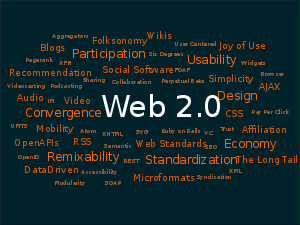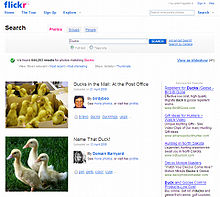VERSION EN INGLES
Web 2.0
A tag cloud (a typical Web 2.0 phenomenon in itself) presenting Web 2.0 themes
The term «Web 2.0» is commonly associated with web applications that facilitate interactive information sharing, interoperability, user-centered design,[1] and collaboration on the World Wide Web. A Web 2.0 site allows its users to interact with each other as contributors to the website’s content, in contrast to websites where users are limited to the passive viewing of information that is provided to them. Examples of Web 2.0 include web-based communities, hosted services, web applications, social-networking sites, video-sharing sites, wikis, blogs, mashups, and folksonomies.
The term is closely associated with Tim O’Reilly because of the O’Reilly Media Web 2.0 conference in 2004.[2][3] Although the term suggests a new version of the World Wide Web, it does not refer to an update to any technical specifications, but rather to cumulative changes in the ways software developers and end-users use the Web. Whether Web 2.0 is qualitatively different from prior web technologies has been challenged by World Wide Web inventor Tim Berners-Lee, who called the term a «piece of jargon»[4] — precisely because he specifically intended the Web to embody these values in the first place.
Characteristics
Flickr, a Web 2.0 web site that allows its users to upload and share photos
Web 2.0 websites allow users to do more than just retrieve information. They can build on the interactive facilities of «Web 1.0» to provide «Network as platform» computing, allowing users to run software-applications entirely through a browser.[3] Users can own the data on a Web 2.0 site and exercise control over that data.[3][14] These sites may have an «Architecture of participation» that encourages users to add value to the application as they use it.[2][3]
The concept of Web-as-participation-platform captures many of these characteristics. Bart Decrem, a founder and former CEO of Flock, calls Web 2.0 the «participatory Web»[15] and regards the Web-as-information-source as Web 1.0.
The impossibility of excluding group-members who don’t contribute to the provision of goods from sharing profits gives rise to the possibility that rational members will prefer to withhold their contribution of effort and free-ride on the contribution of others.[16] This requires what is sometimes called Radical Trust by the management of the website. According to Best,[17] the characteristics of Web 2.0 are: rich user experience, user participation, dynamic content, metadata, web standards and scalability. Further characteristics, such as openness, freedom[18] and collective intelligence[19] by way of user participation, can also be viewed as essential attributes of Web 2.0.
Technology overview
Web 2.0 draws together the capabilities of client– and server-side software, content syndication and the use of network protocols. Standards-oriented web browsers may use plug-ins and software extensions to handle the content and the user interactions. Web 2.0 sites provide users with information storage, creation, and dissemination capabilities that were not possible in the environment now known as «Web 1.0».
Web 2.0 websites typically include some of the following features and techniques. Andrew McAfee used the acronym SLATES to refer to them:[20]
Search
Finding information through keyword search.
Links
Connects information together into a meaningful information ecosystem using the model of the Web, and provides low-barrier social tools.
Authoring
The ability to create and update content leads to the collaborative work of many rather than just a few web authors. In wikis, users may extend, undo and redo each other’s work. In blogs, posts and the comments of individuals build up over time.
Tags
Categorization of content by users adding «tags» – short, usually one-word descriptions – to facilitate searching, without dependence on pre-made categories. Collections of tags created by many users within a single system may be referred to as «folksonomies» (i.e., folk taxonomies).
Extensions
Software that makes the Web an application platform as well as a document server.
Signals
The use of syndication technology such as RSS to notify users of content changes.
While SLATES forms the basic framework of Enterprise 2.0, it does not contradict all of the higher level Web 2.0 design patterns and business models. And in this way, the new Web 2.0 report from O’Reilly is quite effective and diligent in interweaving the story of Web 2.0 with the specific aspects of Enterprise 2.0. It includes discussions of self-service IT, the long tail of enterprise IT demand, and many other consequences of the Web 2.0 era in the enterprise. The report also makes many sensible recommendations around starting small with pilot projects and measuring results, among a fairly long list. [21]

